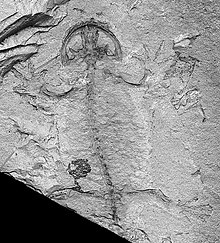Batrachomorpha
| Batrachomorpha Temporal range:
| |
|---|---|

| |
| Pangerpeton, a salamander from the Jurassic | |
| Scientific classification | |
| Domain: | Eukaryota |
| Kingdom: | Animalia |
| Phylum: | Chordata |
| Superclass: | Tetrapoda |
| Clade: | Batrachomorpha Säve-Söderbergh, 1934 |
| Groups | |
| |
The Batrachomorpha ("frog forms") are a
The first
Classification
Etymology
The name Batrachomorpha was coined by the Swedish
Though never a majority view, the notion that tetrapods had evolved twice, together with the usage of the term batrachomorpha, lingered until genetic analysis started confirming the monophyly of living amphibians in the 1990s.[5] Jarviks classification is no longer followed, all living amphibians and their fossil relatives now being classified together in the group Lissamphibia.
Phylogenetics

- Superorder Batrachomorpha
- †Order Edopoidea
- †Family Dendrerpetonidae
- Order unnamed
- †Suborder Dvinosauria
- †Family Branchiosauridae
- †Family Dissorophidae
- Infraclass Lissamphibia
- †Family Albanerpetonidae
- Order extant)
- Order extant)
- Order extant)
- †Order unnamed
- †Family †Eryopidae
- †Family Actinodontidae
- †Family Archegosauridae
- †Family Rhinesuchidae
- †Suborder Capitosauria
- †Suborder Trematosauria
- †Family Trematosauridae
- †Family Metoposauridae
- †Family Plagiosauridae
- †Family Rhytidosteidae
- †Family Brachyopidae
- †Family Chigutisauridae
The other groups of tetrapods considered more closely related to
The phylogenetic relationships of Paleozoic tetrapods have not yet been worked out with certainty, and the validity of Batrachomorpha as a
Anatomy
Batrachomorphs are distinguished by a number of features in the skeleton, including a flat or shallow skull, a fused
In the appendix to
References
- ^ Laurin, M. (1996): Phylogeny of Stegocephalians, from the Tree of Life Web Project
- ^ Säve-Söderbergh, G. (1934). Some points of view concerning the evolution of the vertebrates and the classification of this group. Arkiv för Zoologi 26A: pp 1-20
- ^ von Huene, F. (1956): Paläontologie und Phylogenie der niederen Tetrapoden, G. Fischer, Jena
- ^ Jarvik, E. (1980). Basic structure and evolution of vertebrates. Vol. 2. London: Academic Press.
- ^ San Mauro & al (2005): Initial diversification of living amphibians predated the breakup of Pangaea. American Naturalist no 165: pp 590–599
- ^ )
- ^ Laurin, M. (1996): Terrestrial Vertebrates - Stegocephalians: Tetrapods and other digit-bearing vertebrates
- ^ Benton, M. J. (2000), Vertebrate Paleontology, 2nd Ed. Blackwell Science Ltd 3rd ed, pp.98-99
General references
- Benton, M.J. (2004) taxonomic hierarchy of the vertebrates
- Marjanović, David, (2002) Re: thoughts on which nodes to name Archived 2016-08-06 at the Wayback Machine Dinosaur Mailing List
- Jarvik, E. (1968). Aspects of vertebrate phylogeny. In: Current Problems of Lower Vertebrate Phylogeny (ed. T. Ørvig), Nobel Symposium 4, pp. 497–527. Stockholm, Almqvist & Wiksell.
